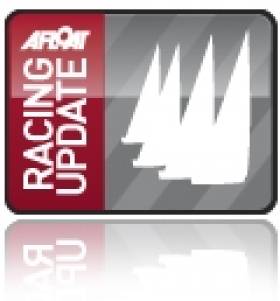Displaying items by tag: Simon Lake
Barry and Kenny on Top form in Cork 5o5 Nationals
12 boats took part in the years 505 Irish Nationals and British Isles Championships. Following a delayed Swansea Cork ferry, the four UK boats made it to MBSC at 12 30pm on Saturday.
Racing on Saturday was held in Cuskinny with the breeze touching 25 knots on the downwind leg to the race area. The OOD team of Ciarán McSweeney and David Barry got racing underway at 3 15pm with the north westerly breeze softening to 12 to 15 knots. Ewen Barry and Simon Lake(8945) lead at mark one followed by Charles Dwyer and Conor Kelly (8961). Dwyer and Kelly's race came to an end at the first gybe mark with an impressive capsize( their first of two in the race). Barry and Lake showed impressive upwind speed with Barry and Kenney flying on the downwind in perfect reaching conditions. Barry and Kenney eventually took the lead on the top reach of the last leg and managed to hold on to take first, Barry and Lake second and Ronan Kenneally and Denis Cartwright taking a well deserved third place.
In race two, Barry and Kenney lead all the way round with some great battles for the 2, 3, 4 positions going on behind. Brian Jones and Gary Frost sailing 7771 came out ahead taking 2nd place with Ewen and Simon in 3rd. With the sun going down and a beat home the OOD team made the call to head for home and the warmth of the clubhouse.
Day 2 again brought great sailing conditions with a cold Northerly breeze and brilliant sunshine, racing got underway again in Cuskinny at 11 30am. Three races were held, in 8 to 12 knots. Denis Cartwright was joined by the third Barry brother Colin for the rest of the weekend as Ronan Kenneally had laser sailing commitments. Barry and Kenney again showed their pace on the day and with two firsts and a fourth were going to be hard to catch. Dwyer and Kelly found their footing with a 3, 1, 2 winning the second race by a considerable margin. Colin and Denis had a very consistent day with a 2, 3, 3 and had some extremely close battles with Dwyer and Kelly. Jones and Frost struggled in the lighter breeze posting a 5, 6, 5 leaving some work to do to catch back up to the group battling for second. Wade and Robert Cuppage added another boat to the racing today in Ethel, possibly one of the most famous 505's around and still sporting a deck stepped mast. Damage to Mikie and Josh's boat caused them to retire from races 4 & 5 with redress granted later as they were found to be not at fault. This meant that the battle for the junior title with James and Lisa O'Brien was hotting up and all to play for on the last day.
Going into the last day, with a gale warning in place for Monday, Alex and Adam lead on 4 points, Charlo and Conor in second on 10 points, Ewen & Simon and Colin & Denis tieing for third on 11 points.
Sunday night brought the usual banter with plenty or arm wrestling, chair jumping and general tough man competitions in the bar and stories of days gone by from Jim.
Monday morning brought new conditions with a strong southerly breeze filling in to the bay. As there were big winds forecasted and ferries to catch, Dave and Ciarán decided to hold racing in the bay. Conditions were good for the 505 with flat water and 18 to 22 knots of breeze. There was no catching Barry and Kenney again with their downwind pace proving to be the winning factor. They posted another two firsts to take the title counting all 1sts. Charlo was joined by Ronan Kenneally this time and despite a lightweight crew they took two seconds on the day to cement their second place overall. With Ewen and Simon breaking an outhaul in the first race they now had to count a 7th and a 3rd in the final race was not enough to fight off Colin and Denis. Brian and Gary's big breeze pace was back and the posted a 3rd and a 4th. Jim and Barney had a great first race taking 5th but a capsize in the second race but them out of the race.
In the juniors, Mikie and Josh posted a 6th and a 7th to take the junior title with Lisa and James' equal 6th and a 7th not enough to catch up.
505 Irish Nationals and British Isles Championships – MSBC 23rd to 25th October 2010
1 IRL/GBR 8945 Alex Barry & Adam Kenny 1 1 1 4 1 1 1
2 IRL 8961 Charles Dwyer & Conor Kelly 7 4 3 1 2 2 2
3 IRL 8497 Colin Barry & Dennis Cartwright 3 5 2 3 3 4 5
4 IRL/GBR 8955 Ewen Barry & Simon Lake 2 3 4 2 7 12 3
5 IRL 7771 Brian Jones & Garry Frost 4 2 5 6 5 3 4
6 GBR 8907 Jim Berry & David Barnes 6 7 6 5 10 5 10
7 IRL 8552 Michael O'Brien & John O'Gorman 5 6 7 8 4 12 13
8 IRL 8380 Charles & Jeannie McCarthy 8 8 8 7 6 12 8
9 IRL 8*08 Mike O'Brien & Josh Barrett 10 10 9 APA8.4 APA8.4 6 7
10 IRL 8679 James & Lisa O'Brien 9 9 11 10 8 7 6
11 IRL 8216 Joanne McCarthy & Steven O'Reilly 13 13 10 9 9 12 13
12 IRL 7852 Wade & Robert Cuppage 13 13 13 11 11 13 13





























































